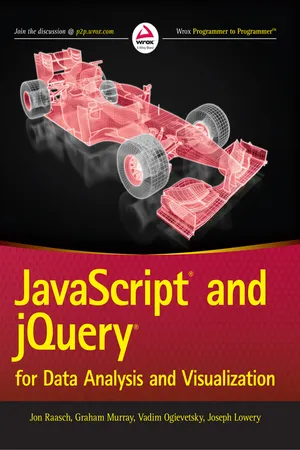
JavaScript and jQuery for Data Analysis and Visualization
Jon Raasch, Graham Murray, Vadim Ogievetsky, Joseph Lowery
- English
- ePUB (mobile friendly)
- Available on iOS & Android
JavaScript and jQuery for Data Analysis and Visualization
Jon Raasch, Graham Murray, Vadim Ogievetsky, Joseph Lowery
About This Book
Go beyond design concepts—build dynamic data visualizations using JavaScript
JavaScript and jQuery for Data Analysis and Visualization goes beyond design concepts to show readers how to build dynamic, best-of-breed visualizations using JavaScript—the most popular language for web programming.
The authors show data analysts, developers, and web designers how they can put the power and flexibility of modern JavaScript libraries to work to analyze data and then present it using best-of-breed visualizations. They also demonstrate the use of each technique with real-world use cases, showing how to apply the appropriate JavaScript and jQuery libraries to achieve the desired visualization.
All of the key techniques and tools are explained in this full-color, step-by-step guide. The companion website includes all sample codes used to generate the visualizations in the book, data sets, and links to the libraries and other resources covered.
- Go beyond basic design concepts and get a firm grasp of visualization approaches and techniques using JavaScript and jQuery
- Discover detailed, step-by-step directions for building specific types of data visualizations in this full-color guide
- Learn more about the core JavaScript and jQuery libraries that enable analysis and visualization
- Find compelling stories in complex data, and create amazing visualizations cost-effectively
Let JavaScript and jQuery for Data Analysis and Visualization be the resource that guides you through the myriad strategies and solutions for combining analysis and visualization with stunning results.
Frequently asked questions
Information
PART I
The Beauty of Numbers Made Visible
- Chapter 1: The World of Data Visualization
- Chapter 2: Working with the Essentials of Analysis
- Chapter 3: Building a Visualization Foundation
Chapter 1
The World of Data Visualization
What's in This Chapter
- Overview of chart design options
- Comparison of different business applications for data visualization
- Rundown of technological advancements that have made data visualization what it is today